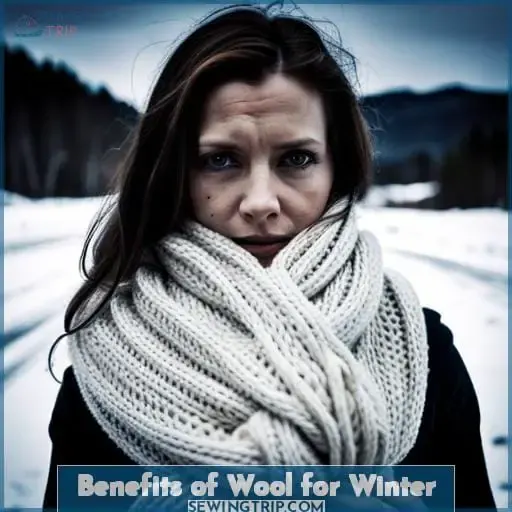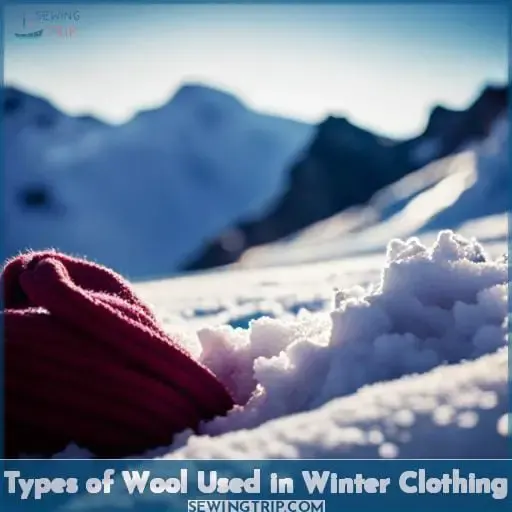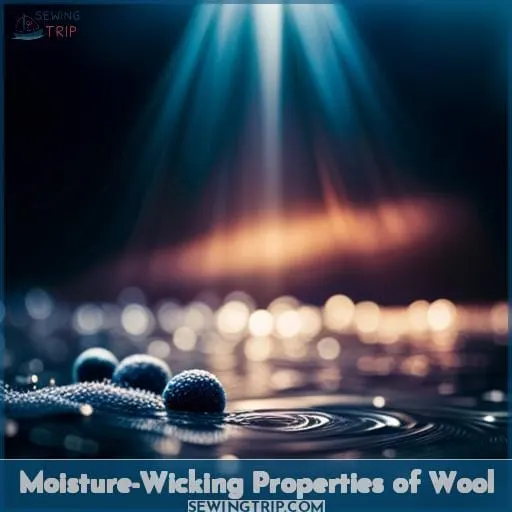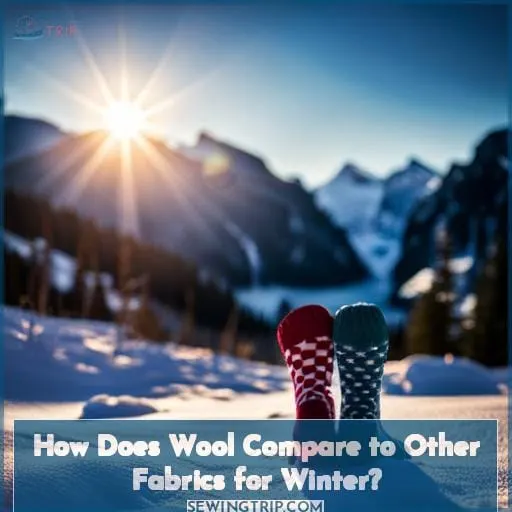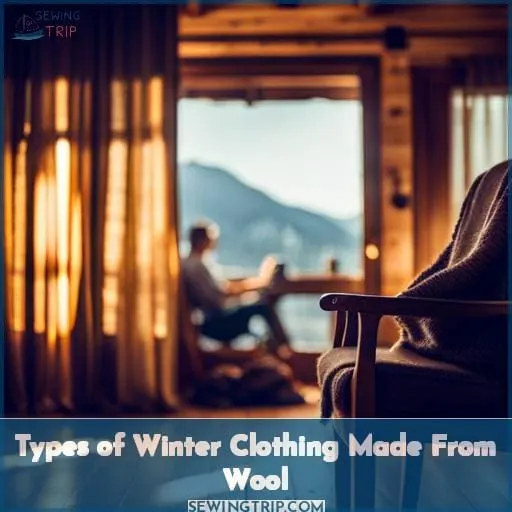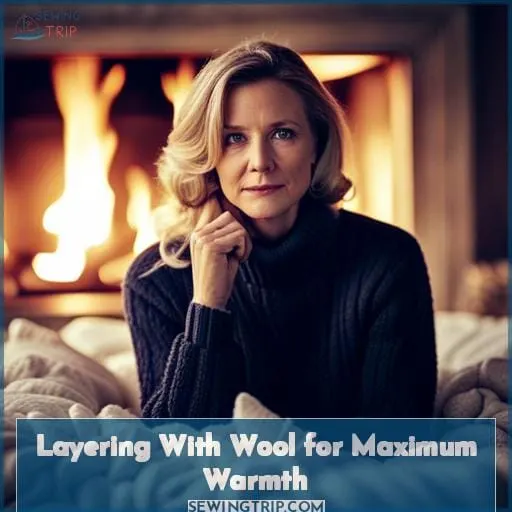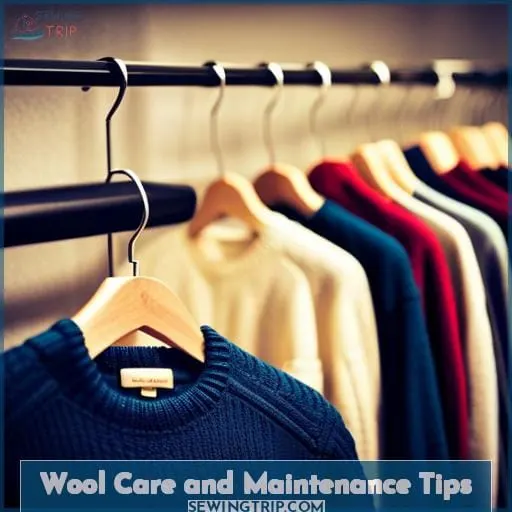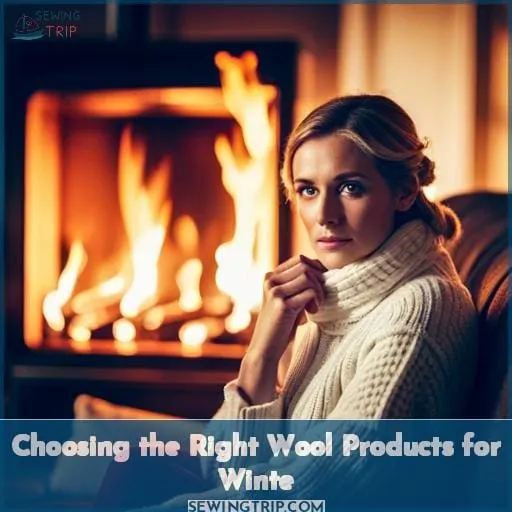This site is supported by our readers. We may earn a commission, at no cost to you, if you purchase through links.
 Picture this:
Picture this:
You step outside on a chilly winter morning, bundled up in your cozy wool coat. As you walk down the street, you can’t help but notice how warm and snug you feel compared to those around you.
That’s the power of wool – it’s nature’s ultimate insulator.
In this article, we’ll explore the benefits of wool for winter wear, discuss different types of wool and how they keep you warm, and share tips on caring for your favorite wool pieces.
Get ready to conquer winter in style with the warmth of wool!
Table Of Contents
- Key Takeaways
- Benefits of Wool for Winter
- Types of Wool Used in Winter Clothing
- How Does Wool Keep You Warm?
- Moisture-Wicking Properties of Wool
- Insulation and Breathability of Wool
- How Does Wool Compare to Other Fabrics for Winter?
- Types of Winter Clothing Made From Wool
- Layering With Wool for Maximum Warmth
- Wool Care and Maintenance Tips
- Choosing the Right Wool Products for Winte
- Frequently Asked Questions (FAQs)
- Conclusion
Key Takeaways
- Wool’s moisture-wicking properties keep you dry and comfortable.
- Wool’s insulation properties trap heat close to your body.
- Wool’s natural air pockets create a comfortable microclimate.
- Wool’s hygroscopic nature allows it to absorb moisture without feeling wet.
Benefits of Wool for Winter
When it comes to staying warm in the winter, wool is your best friend.
Its moisture-wicking properties keep you dry and comfortable by pulling sweat away from your body.
Not only does wool provide excellent insulation, trapping heat close to your skin, but it also retains its warmth even when wet.
Plus, with its durability and long-lasting performance, a quality wool garment will keep you cozy for many winters to come.
Wool’s moisture-wicking properties
One of the key reasons why wool is a great choice for winter clothing is because it has exceptional moisture-wicking properties, keeping you dry and comfortable all day.
Wool’s hygroscopic nature allows it to efficiently manage moisture by absorbing and releasing water vapor through its fibers. This drying mechanism helps regulate humidity levels, ensuring that you stay warm without feeling damp or sweaty.
The wicking efficiency of wool makes it an excellent option for heat insulation in winter clothing.
Insulation and heat retention
To further enhance your understanding of how wool keeps you warm, let’s explore its exceptional insulation and heat retention properties.
Wool acts as a natural insulator, creating a cozy microclimate that traps heat close to your body.
Its unique structure allows it to retain warmth even when wet, making it an ideal choice for winter wear.
Experience the elegance of woolen warmth and unlock its cozy secret for ultimate comfort in cold weather.
Durability and long-lasting warmth
When choosing a winter garment, it’s important to consider the durability and long-lasting warmth that wool provides.
Wool offers wear and tear resistance, making it ideal for enduring harsh winter conditions.
It’s also resistant to mold and mildew, ensuring your garment stays fresh season after season.
Additionally, wool is durable against abrasion and can withstand repeated washings without losing its insulating properties or shrinking in size.
Types of Wool Used in Winter Clothing
When it comes to winter clothing, different types of wool offer varying levels of warmth and comfort.
Merino wool is known for its ability to regulate body temperature effectively.
Cashmere wool, although lightweight, provides luxurious softness but tends to be pricier.
Alpaca and camel hair wools offer unique properties such as a golden brown hue or medium-weight fabric options.
Understanding the characteristics of these different types can help you choose the perfect winter garment that suits your needs and preferences while keeping you warm throughout the season.
Merino Wool
If you frequently engage in outdoor activities during the winter, you’ll love merino wool for its exceptional warmth and comfort. It’s renowned as one of the warmest and most breathable materials available. Whether it’s a cozy sweater or soft socks, merino wool is the best choice for staying warm ethically.
Cashmere Wool
For maximum warmth and luxury, consider incorporating cashmere wool into your winter wardrobe.
Cashmere origins from the undercoat of cashmere goats, making it a rare and prized material.
The benefits include unparalleled softness, lightweight feel, excellent insulation properties, and breathability.
Alpaca Wool
Now let’s delve into the next type of wool used in winter clothing: Alpaca Wool.
Known for its exceptional softness and warmth, alpaca wool is a luxurious choice for cold weather garments. Its natural insulating properties provide excellent heat retention, while also being hypoallergenic and resistant to pilling.
Camel Hair Wool
Continuing with our exploration of different types of wool used in winter clothing, let’s delve into the warmth and versatility offered by camel hair wool.
Camel hair is:
- Hypoallergenic
- Breathable
- Durable
- lightweight
-naturally water-resistant.
How Does Wool Keep You Warm?
To understand how wool keeps you warm, let’s delve into its unique properties and mechanisms.
Wool is a remarkable natural fiber that works in harmony with your body to provide warmth and comfort in cold weather.
- Wool and Water Vapor: Wool has the ability to absorb moisture from the air while still feeling dry to the touch. This prevents sweat from clinging to your skin, keeping you cozy even when humidity levels rise.
- Wool and Heat: When wool absorbs water vapor, it undergoes an exothermic process that releases heat. This means that as moisture is absorbed by the fibers of the wool, it generates warmth naturally.
- Wool and Temperature Regulation: The insulation properties of wool help regulate your body temperature by trapping pockets of warm air close to your skin. It acts as a barrier against external temperatures, keeping you snug when it’s chilly outside.
- Wool and Humidity Control: Unlike synthetic materials which can feel clammy against your skin when wet or sweaty, wool wicks away moisture efficiently due to its hygroscopic nature. It creates a micro-environment next to your skin that combats humidity-induced chilliness.
- Skin-Friendly Properties: The structure of individual woven or knitted fibers allows for breathability while preventing drafts from entering through gaps between threads or stitches—providing maximum comfort without compromising on style.
Wool truly is a magical fabric designed for ultimate winter coziness!
Moisture-Wicking Properties of Wool
To experience the full benefits of wool in winter, you’ll appreciate its moisture-wicking properties.
Wool’s ability to absorb and manage moisture sets it apart from other fabrics. When you’re out in the cold, your body produces sweat as a way to regulate temperature. Unlike synthetic materials that trap moisture against your skin, wool’s natural fibers work with your body by pulling away excess moisture and allowing it to evaporate into the air.
Wool’s unique structure enables it to absorb up to 30% of its weight in water without feeling wet or losing its insulating properties. The outer layer of wool has scales that repel liquid water while still allowing vapor molecules from sweat or humidity in the environment to pass through.
In addition, when wool absorbs moisture, an exothermic process occurs where heat is released as a result of hydrogen bonds forming between water molecules and polar groups within the fiber structure. This means that even if you do get wet while wearing wool, it will continue generating warmth instead of making you feel colder like other fabrics would.
Overall, thanks to its excellent moisture management capabilities combined with insulation properties,
wool is an ideal choice for staying warm and dry during winter activities.
Insulation and Breathability of Wool
When it comes to staying warm during winter, wool is a top choice due to its exceptional insulation and breathability.
Wool’s natural air pockets trap heat close to your body, keeping you cozy in chilly temperatures.
Additionally, wool has excellent moisture management properties that allow for proper ventilation and prevent overheating or excess perspiration buildup.
Wool’s Natural Air Pockets
To experience the insulation and breathability of wool, you can rely on its natural air pockets.
These air pockets, varying in size and shape, are densely packed within the structure of wool fibers.
The composition and structure of these air pockets allow them to:
- Trap warm air close to your body
- Allow for proper airflow
- Manage moisture efficiently
This unique combination provides excellent insulation against cold temperatures while preventing overheating or excessive sweating.
Wool’s natural ability to create a comfortable microclimate makes it an ideal choice for staying warm this winter.
Wool’s Moisture Management
When it comes to moisture management, wool excels in insulation and breathability.
Its hydrophobic cuticle resists internal water absorption, making it slow but effective in the adsorption of water vapor. This unique property allows wool to generate heat through the adsorption of water vapor, keeping you warm even when wet.
Additionally, wool insulates body heat without absorbing excess heat from your body. It acts as a natural barrier that traps warm vapor, moisture, and heat within its fibers while still allowing for proper airflow and breathability.
How Does Wool Compare to Other Fabrics for Winter?
When it comes to comparing wool to other fabrics for winter, there are a few key points to consider.
First, let’s look at wool versus polyester. Wool is known for its superior insulation properties and ability to retain warmth even when wet, while polyester tends to be less breathable and can trap moisture against the skin.
Next up is wool versus cotton – while cotton may feel cozy initially, it lacks the same insulating qualities as wool and can actually draw heat away from the body when damp or wet.
Finally, we’ve silk compared with wool – silk offers a lightweight option but doesn’t provide the same level of warmth as wool in colder temperatures.
Wool Vs. Polyester
When comparing wool to polyester for winter fabrics, it’s important to consider their different properties and performance in terms of warmth and comfort.
- Wool offers superior breathability, wicking away moisture from the body.
- It has natural elasticity and durability, making it resistant to shedding and abrasion.
- Polyester provides wrinkle resistance and lower cost compared to wool.
- However, polyester lacks the same level of insulation as wool.
Wool Vs. Cotton
When comparing wool to cotton for winter clothing, it’s important to consider the unique properties and benefits of each fabric.
Wool is known for its excellent insulation and moisture-wicking abilities, while cotton is breathable and lightweight.
Here’s a comparison table highlighting the differences between wool and cotton:
| Wool | Cotton | |
|---|---|---|
| Insulation | Excellent insulator that retains heat even when wet | Less effective at retaining heat |
| Moisture Management | Wicks away moisture from the body | Absorbs moisture but takes longer to dry |
| Breathability and Comfort |
Textile engineer’s gaze:
Both fabrics have their advantages in winter wear – wool excels in insulation by trapping warmth even when wet, while cotton provides breathability for comfort. However, if you’re looking for optimal warmth retention during cold weather activities or extreme conditions, wool would be your best choice due to its superior insulation capabilities.
Wool Vs. Silk
If you frequently find yourself in cold weather, you’ll love how wool compares to silk for winter wear.
- Wool is more durable than silk, making it a better investment for long-lasting warmth.
- Wool is more water-resistant than silk, keeping you dry and comfortable even in wet conditions.
- Wool is more breathable than silk, allowing your body to regulate temperature and prevent overheating.
So ditch the fragile and expensive silk this winter and opt for the reliable warmth of wool instead!
Types of Winter Clothing Made From Wool
When it comes to staying warm in the winter, wool is a versatile and reliable choice for your wardrobe.
Wool coats and jackets provide excellent insulation against the cold while still being stylish.
Wool sweaters and cardigans are cozy layers that can be easily paired with any outfit.
Don’t forget about accessories like wool hats, scarves, socks, and base layers that add an extra level of warmth to keep you comfortable all season long.
Wool Coats and Jackets
To stay warm this winter, consider investing in wool coats and jackets, which provide excellent insulation and moisture-wicking properties.
Choose a wool coat length that suits your style and climate.
Explore different styles, from classic pea coats to trendy oversized jackets.
Don’t forget to select colors that complement your wardrobe.
Proper care will ensure the longevity of your wool coat investment while keeping you cozy all season long.
Wool Sweaters and Cardigans
Stay cozy and stylish this winter with a wide variety of wool sweaters and cardigans, offering you warmth, comfort, and versatility.
- Shape: Choose from fitted or oversized styles for different looks.
- Layering: Use wool sweaters/cardigans as a layering piece for added warmth.
- Color/Pattern: Explore various colors/patterns to express your personal style.
- Texture/Feel: Enjoy the luxurious texture and softness of wool.
Wool Hats and Scarves
As we explore winter clothing made from wool, let’s focus on the cozy and stylish accessories – wool hats and scarves.
These essential pieces provide warmth while maintaining breathability. They combine style and function, allowing you to accessorize your look with ease.
Be sure to choose the right size for a comfortable fit and care for your wool hats and scarves properly to keep them in top condition.
Wool Socks and Base Layers
For maximum warmth and comfort during the winter months, consider incorporating wool socks and base layers into your cold-weather wardrobe.
Why?
Because wool socks:
- Prevent blisters
- Wick moisture away from your skin
- Protect your skin from friction
- Keep your feet warm in chilly conditions
- Are incredibly durable for long-lasting wear
Layering With Wool for Maximum Warmth
To maximize warmth, layering with wool is essential.
When it comes to staying warm during the winter months, wearing multiple layers of wool can provide optimal insulation and comfort.
Start with a base layer made of lightweight wool thermals or long johns to trap body heat close to your skin. These snug-fitting garments will wick away moisture and keep you dry throughout the day.
Next, add a mid-layer such as a cozy wool sweater or cardigan. The thick fibers of these garments create additional air pockets that help retain heat and provide extra insulation against the cold.
For outer layers, consider investing in a high-quality wool coat or jacket that will shield you from harsh winds while still allowing your body to breathe. Pair this with accessories like hats, scarves, gloves or mittens made from soft and insulating materials like merino or alpaca wool for added warmth around exposed areas.
Don’t forget about your lower half! Opt for leggings designed specifically for cold weather activities such as hiking or skiing – these are often crafted from moisture-wicking merino wool blends that offer both comfort and maximum thermal regulation.
By incorporating different weights of woollen clothing into your outfit – starting with base layers followed by mid-layers – you’ll ensure ultimate warmth retention without sacrificing mobility.
Wool Care and Maintenance Tips
When it comes to taking care of your wool garments, it’s important to follow a few simple tips. Wool is a delicate fabric that requires special attention to ensure its longevity and performance.
Here are some essential care and maintenance tips for your wool:
- Dry Cleaning: For heavily soiled or structured wool items like coats, dry cleaning is the best option.
- Air Dry: After washing your wool garments by hand, avoid using the dryer as heat can damage the fibers. Instead, gently squeeze out excess water and lay them flat on a clean towel or drying rack to air dry.
- Flat Fold: When storing wool items such as sweaters or scarves, fold them flat instead of hanging them to prevent stretching.
Taking these steps will help preserve the quality and appearance of your beloved woollen pieces while ensuring they keep you warm throughout this winter season!
Choosing the Right Wool Products for Winte
When it comes to staying warm in the winter, wool is your best friend. Its insulation properties make it an excellent choice for keeping out the cold and trapping body heat. However, not all wool products are created equal when it comes to warmth. Factors such as the type of wool used and other design features can affect how warm a garment will be.
So, let’s delve into choosing the right wool products that will truly keep you cozy this winter season.
Wool insulation properties
To choose the right wool products for winter, consider their insulation properties.
Wool’s hygroscopic nature allows it to absorb moisture without feeling wet, making it an excellent choice for staying warm even in damp conditions. Unlike cotton, which absorbs water and loses its insulating properties when wet, wool continues to provide warmth due to its exothermic reaction with moisture.
Its superior heat retention makes wool a top contender for keeping you cozy all winter long.
Choosing the right wool
First, consider your specific needs and preferences when choosing the right type of wool for winter.
Look for high-quality wool products with a high wool content to ensure warmth and durability.
Pay attention to different types of wool like merino, cashmere, alpaca, and camel hair which offer varying levels of insulation.
Also, consider any fiber blends that may affect the overall quality and performance of the garment.
Don’t forget to check care instructions for proper washing techniques and be mindful of any potential allergies or sensitivities you may have towards certain types of wool.
Factors affecting warmth
To ensure maximum warmth during winter, consider various factors that can affect the performance of wool products.
Wool’s thermal conductivity and insulation properties create air pockets that trap heat, while its moisture-wicking capabilities aid in sweat evaporation and moisture transfer.
Layering with wool enhances heat retention by creating additional insulation layers.
By understanding these factors, you can choose the right wool products to stay warm and comfortable throughout the winter season.
Frequently Asked Questions (FAQs)
Can wool be worn in wet and snowy conditions without losing its warmth?
Wool is a powerful ally in wet and snowy conditions, keeping you warm and protected.
Its hydrophobic cuticle resists water absorption while its insulation properties trap warmth, ensuring your comfort in challenging weather.
Is wool suitable for people with sensitive skin or allergies?
Wool is a great choice for people with sensitive skin or allergies.
Its natural fibers are hypoallergenic and gentle on the skin, providing warmth without irritation.
Embrace the liberation of cozy comfort!
Can wool be worn as a base layer for winter sports activities?
Wool is an excellent choice as a base layer for winter sports activities.
Its natural insulation properties trap heat, keeping you warm and comfortable during your adventures on the slopes or in the wilderness.
Does the thickness of the wool affect its warmth?
The thickness of wool significantly impacts its warmth.
Thicker wool provides greater insulation, trapping more heat and keeping you cozy in cold weather.
Opt for thicker wool if maximum warmth is your priority this winter!
How does the quality of wool affect its performance in winter weather?
The quality of wool significantly impacts its winter performance.
High-quality wool, such as merino, can provide exceptional warmth while maintaining breathability and moisture-wicking properties.
Don’t settle for less when it comes to staying cozy in the cold.
Conclusion
To stay warm and stylish this winter, embrace the power of wool.
With its moisture-wicking properties, insulation, and durability, wool is nature’s ultimate insulator.
Whether it’s merino wool, cashmere wool, alpaca wool, or camel hair wool, each type offers unique benefits for winter wear.
From wool coats and jackets to sweaters, hats, scarves, and socks, there are endless options to keep you cozy.
Remember to layer with wool for maximum warmth and follow proper care and maintenance tips to ensure your favorite wool pieces last for seasons to come.
Embrace the warmth of wool and conquer winter in style.

